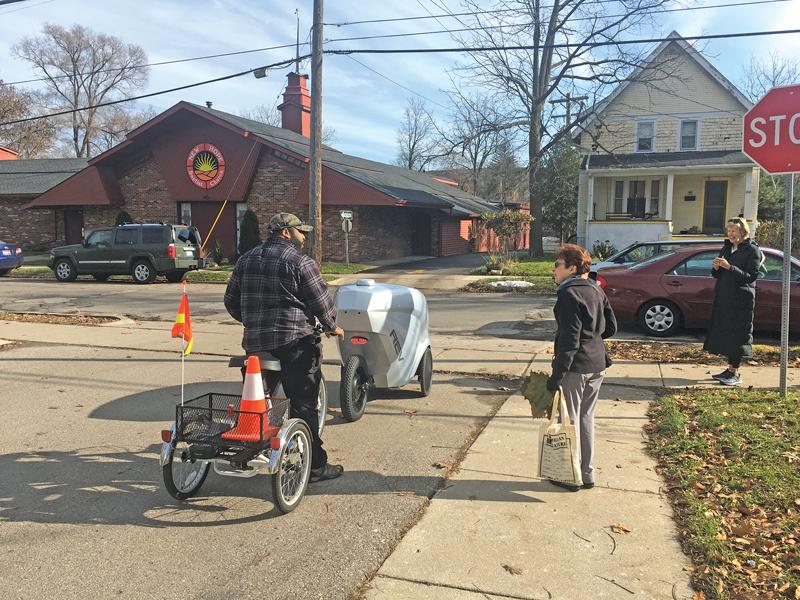They aren’t very big–about the size of a child’s bike–and there aren’t very many of them–just five at the moment. But “we’ve been doing deliveries every day out of this office,” says Johnson-Roberson. And the U-M robotics prof thinks the REV-1, the self-driving, bicycle-wheeled robot he and mechanical engineering prof Ram Vasudevan developed, makes a lot more sense for short-range food deliveries than DoorDash or Uber Eats sending a car and driver.
The car-based companies, Johnson-Roberson says, typically keep 30 percent of the bill. “If you talk to the restaurants, they really don’t care for that,” he says. “It’s actually very difficult for them to make a business out of that. So one of the things that motivated us to do this was just that that seemed like an unsustainable model.”
He says the company they founded, Refraction AI, charges restaurants 15 percent, and customers pay $3. By comparison, “You can pay anywhere from $5 to 8, or $10 to $12 with tip, on Grubhub.”
The REV-1 is still in the pilot phase, with about 400 users ordering food from Miss Kim, Chow, Tios, Belly Deli, and Grabbagreen. But Johnson-Roberson says they’ve been surprised by the wide range of people who are interested in taking part, from college students to retirees. “The feedback is people are very excited. They hear a lot about autonomous vehicles–there are a lot of news stories–but it’s very rare to get the opportunity to actually interact with one.”
The REV-1 is small enough to travel in the bike lane, which has led to online posts wondering whether the machines will obstruct or endanger bicyclists.
Johnson-Roberson says that the vehicle complies with “all the classifications of a Class Two e-bike, which is allowed to run on city streets and in bike lanes all over the state of Michigan”–but “eighty to ninety percent of our time, we’re in the streets in Ann Arbor, not the bike lanes.”
Johnson-Roberson, a bicyclist himself, says the REV-1 is programmed to behave predictably when it detects a bicycle behind it: “It maintains its speed, so if you want to pass it, you know it’s not going to lurch forward or back into you … And then if the cyclist passes, which is typically what happens, we don’t make any sudden movements left or right, and then if the cyclist begins to merge in front of us, we gradually slow down” to let it pull ahead.
“We meet all of the requirements and insurance holdings and everything else for the state’s [electric vehicle] testing,” he adds. “So in the same way there is a lot of Waymo [self-driving vehicles] on the streets here, we are doing the same thing, but with a lighter, safer vehicle.”
Like Waymo’s Chrysler minivans, each REV-1 has a human monitor. Since there’s no room for a person to ride, though, Refraction’s “teleoperators” monitor three vehicles at a time from its downtown office. And to have “a human there if something goes wrong” during the pilot phase, communications rep Cindy Huynh emails, a “safety operator” follows behind on a bicycle.
A worker at Miss Kim says the safety operator also sometimes picks up the food and loads it into the vehicle. Most of the time, though, the restaurant and customer do that themselves, after being texted a four-digit code that unlocks the delivery compartment for loading and unloading.
City transportation manager Eli Cooper says a “micromobility” subcommittee is looking at regulatory questions raised by the introduction of e-scooters, e-bikes, and now, food delivery robots. “A strict definition of a bicycle lane is that equipment in a bicycle lane needs to be a bicycle and human-powered,” he says, “but we have that under review.”
Johnson-Roberson says Refraction is considering expanding into other cities in Michigan before venturing out around the country. “We’re open to being in other states, but Ann Arbor is the place for us to learn what works and what doesn’t; how to scale; what the economics look like. But to grow from here is really our goal … The plan is to keep all of the R&D, all of the engineering, and in fact all the manufacturing in southeastern Michigan.”
Refraction is backed by San Francisco venture capital firm Trucks and eLab Ventures, based in Ann Arbor and Silicon Valley. Roush Industries is building the body shells. Huynh says the robots cost about $4,000 apiece, and so far, no one is renting or purchasing them–just paying for the service they provide. But Refraction hopes that changes, too.
Johnson-Roberson says they’re asking themselves “what process, and what type of vehicle assembly, works for 1,000 vehicles? There are a lot of challenges around how to scale that. But we really want to come up with the right business case … we’re talking to a lot of big companies about what their needs are for delivery and for moving goods around.
“From a practical perspective, we’re doing a lot of learning–making the vehicle more effective, safer, faster, more efficient. Part of that is figuring out how to use what sensors we have better and then what new sensors and new technology we can integrate, what can we do to make it cheaper and also safer?
“I could build a vehicle that costs $150,0000,” he says. “But I don’t understand how you deliver a burrito with that and make any money.”
